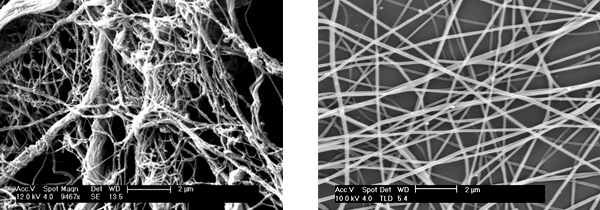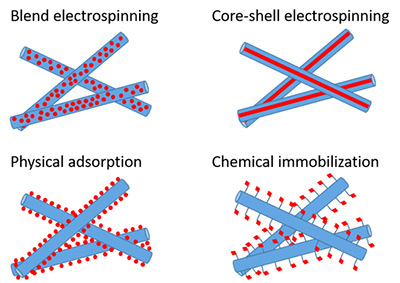Electrospun Scaffolds that are Thermolabile Bioactive
Scaffolding techniques such as 3D printing and melt electrospinning can resemble the extracellular matrix (ECM) environment, however, due to the high temperatures involved they do not allow the process of thermolabile bioactives. These high temperatures denature bioactives (e.g. proteins or amino acids), deactivating them or create unwanted reactions between polymer-bioactives the result of which are undesired. When thermal sensitive material needs to be incorporated into a scaffold material, a different scaffold creating technique needs to be implemented.
An alternate technique involves fibrous scaffolds made through solution based electrospinning. The electrospinning technique creates fibers but does not involve high temperatures. This allows the incorporation of thermal sensitive bioactives during sample formation. Growth factors, dyes, protein, amino acids, short genes and even cells are among the most common bioactives incorporated into electrospun fibers. The beauty of the electrospinning fiber forming technique is that different structural architectures are possible. From single phase, yanus morphology, core-shell, and multi-axial fibers are among the many structural possibilities.

While home-build units can create electrospun fibers, only the Fluidnatek® line allows the production of reproducible fibers from batch-to-batch, day-to-day and season-to-season. This is crucial, not only when expensive bioactives are needed for a specific application, but when trustworthy results need to be translated from the in vitro to the in vivo environment, especially when a sample will be implemented on a patient. All Fluidnatek® units are able to implement all this in single phase or core-shell morphology with a wide range of bioactives for wound healing, tissue regeneration and delivery of drugs or cells into a specific affected area, among others.
Approaches for Incorporating Bioactives into Spun Scaffolds
While a bioactive can be incorporated in either the shell or the core of a core-shell fiber, one of the main advantages of incorporating a bioactive into the core is to protect it from the harsh in vivo environment before the shell is degraded. This will allow the proper delivery of the bioactive into the affected area by either tailoring the drug delivery rate or amount of bioactive to be delivered to the surroundings. Another advantage of using electrospun scaffolding material is the ease of post-processing to incorporate bioactives by either physical adsorption, chemical immobilization, CO2 infusion, among others. The image below shows a few examples of how bioactives can be incorporated into electrospun fibers before, during or post-spinning.

The use of electrospun scaffolding material for tissue engineering and regenerative medicine has become more popular, especially in academic research, startup companies and industry. Typical home built units are not able to achieve production rates needed for commercialization and client demand. Meanwhile, the Fluidnatek® line has been able to achieve the use of more than 5,000 emitters, continuous liquid flow, and production rates of more than 2,000 g h-1 (depending on solution properties). When the standard features of the electrospinning equipment are not enough these units can be engineered to fulfill application specific needs such as all stainless steel components to comply with pharmaceutical production requirements.
While home-built electrospinning units allow the creation of electrospun scaffolding material for tissue engineering and regenerative medicine applications, without a good environmental control unit, the variability and reproducibility of fiber morphology and production is not regulated. The Fluidnatek® line offers the solution to this problem by having a temperature and humidity conditioning unit. This unit can condition the air before it enters the spinning chamber and with an actively regulated exhaust system the spinning environment remains stable during production with no build-up of solvent vapors, something that a typical home-built unit cannot perform.
